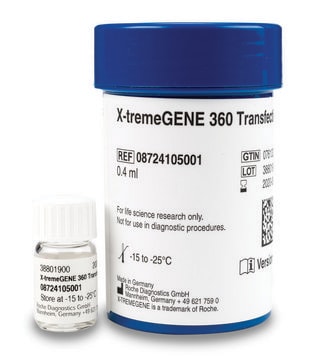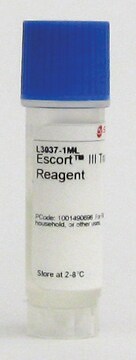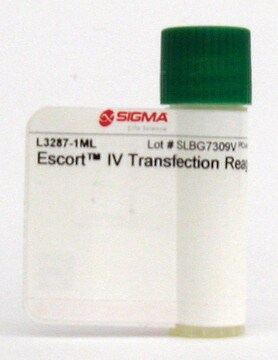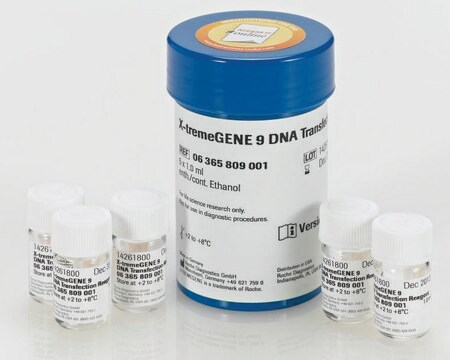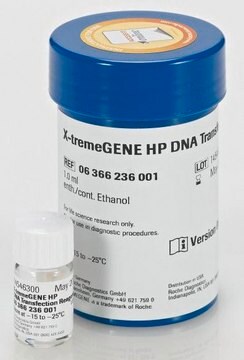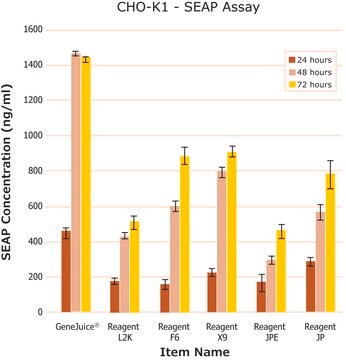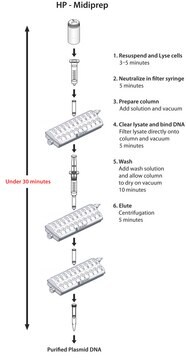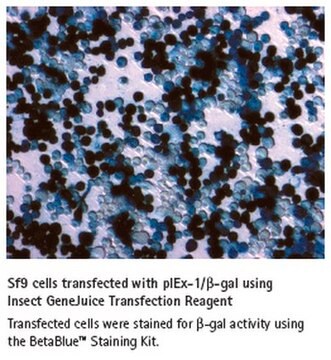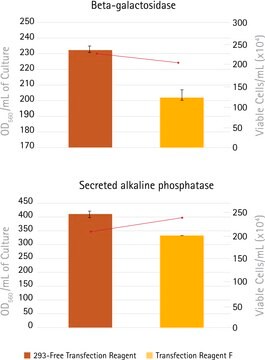T0956
Sigma Universal Transfection Reagent
Polymer reagent for transfecting common mammalian cell lines
Zaloguj sięWyświetlanie cen organizacyjnych i kontraktowych
About This Item
Kod UNSPSC:
12352202
Polecane produkty
klasa czystości
for molecular biology
Poziom jakości
sterylność
aseptically filled
Postać
liquid (buffered aqueous solution)
zastosowanie
sufficient for 110 transfections (3.5 cm dish)
sufficient for 40 transfections (10 cm dish)
sufficient for 65 transfections (6 cm dish)
stężenie
2 mg/mL
temp. przechowywania
−20°C
Opis ogólny
Sigma Universal Transfection Reagent is a unique formulation of a biodegradable, proprietary cationic polymer conjugated to a cationic lipid. Universal Transfection Reagent is used for transfection of nucleic acids into common eukaryotic cell lines. Fast and easy protocol is compatible with serum, serum-free medium and antibiotics. For most cells, medium change after transfection is not necessary.
Zastosowanie
Suitable for transient and stable transfection of nucleic acids into cultured eukaryotic cells. Use approximately 1-3 μl Universal Transfection Reagent per μg DNA. Protocol optimization provides very efficient transfection. The following cells have been successfully transfected using Sigma Universal Transfection Reagent:
Excellent for:
BHK-21
CHO
CHOK1
HEK293
HeLa
NIH3T3
Good for:
3LL
6CSFME
ATT20B16-F0
B16-F10
BAEC
Ca Ski
COS-7
CV-1
D 407
HUVEC
L929
MCF-7
MDCK
Neuro2A
SAOS-2
SHEP
SiHa
SKOV3
Excellent for:
BHK-21
CHO
CHOK1
HEK293
HeLa
NIH3T3
Good for:
3LL
6CSFME
ATT20B16-F0
B16-F10
BAEC
Ca Ski
COS-7
CV-1
D 407
HUVEC
L929
MCF-7
MDCK
Neuro2A
SAOS-2
SHEP
SiHa
SKOV3
Cechy i korzyści
- Fast, easy protocol
- Suitable for stable and transient transfection
- High efficiency for a wide variety of cell types including primary cells
- Compatible with both serum and serum-free transfection protocols
Komponenty
Note the formulation of Sigma Universal Transfection Reagent is confidential.
Zasada
Sigma Universal Transfection Reagent is a cationic polymer conjugated to a cationic lipid. When mixed with plasmid DNA, the reagent forms stable complexes that can be directly added to the cell culture. The cells take up the complexes by endocytosis, the polymer is cleaved from the complex, and the plasmid DNA is quickly released into the cytoplasm.
Inne uwagi
Complex formation is inhibited by serum, but once stable complexes have formed, the presence of serum lowers the toxicity of transfection.
Ta strona może zawierać tekst przetłumaczony maszynowo.
produkt powiązany
Numer produktu
Opis
Cennik
Kod klasy składowania
12 - Non Combustible Liquids
Klasa zagrożenia wodnego (WGK)
WGK 1
Temperatura zapłonu (°F)
Not applicable
Temperatura zapłonu (°C)
Not applicable
Certyfikaty analizy (CoA)
Poszukaj Certyfikaty analizy (CoA), wpisując numer partii/serii produktów. Numery serii i partii można znaleźć na etykiecie produktu po słowach „seria” lub „partia”.
Masz już ten produkt?
Dokumenty związane z niedawno zakupionymi produktami zostały zamieszczone w Bibliotece dokumentów.
Klienci oglądali również te produkty
Pan Pan et al.
Nature communications, 12(1), 4664-4664 (2021-08-04)
Excessive inflammatory responses induced upon SARS-CoV-2 infection are associated with severe symptoms of COVID-19. Inflammasomes activated in response to SARS-CoV-2 infection are also associated with COVID-19 severity. Here, we show a distinct mechanism by which SARS-CoV-2 N protein promotes NLRP3
Nasz zespół naukowców ma doświadczenie we wszystkich obszarach badań, w tym w naukach przyrodniczych, materiałoznawstwie, syntezie chemicznej, chromatografii, analityce i wielu innych dziedzinach.
Skontaktuj się z zespołem ds. pomocy technicznej